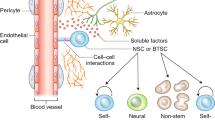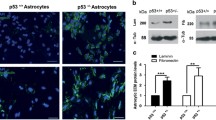Abstract
Our recent study demonstrated that glutamine synthetase (GS) may not only serve as a glutamate-converting enzyme in glial cells, but may also function as a regulator of astrocyte migration after injury. In this report, we showed that GS expression increased in cultured rat C6 glioma cells that underwent long-term serially propagation. The stable overexpression of GS in C6 glioma cells resulted in growth arrest and motility suppression; however the stable knockdown of GS resulted in motility enhancement. In correlation with cell aggregation, N-cadherin levels increased at sites of cell–cell contact in C6 cells overexpressing GS, and decreased in C6 cells with stable GS knockdown; total N-cadherin expression levels remained unchanged in these cells. In addition, levels of p21, a potent cyclin-dependent kinase inhibitor, increased, while cyclin D1 levels decreased in C6 cells overexpressing GS. Our additional studies showed that N-cadherin-mediated cell–cell contacts were implicated in GS-induced cell growth arrest and impairment of cell migration, as evidenced by the inhibition of GS on cell growth and motility by the neutralizing anti-N-cadherin monoclonal antibody (GC-4 mAb). Collectively, these observations suggest a novel mechanism of growth regulation by GS that involves N-cadherin mediated cell–cell contact.





Similar content being viewed by others
References
Fomchenko EI, Holland EC (2005) Stem cells and brain cancer. Exp Cell Res 306:323–329
Zhu Y, Parada LF (2002) The molecular and genetic basis of neurological tumours. Nat Rev Cancer 2:616–626
DeAngelis LM (2001) Brain tumors. N Engl J Med 344:114–123
Bello L, Giussani C, Carrabba G, Pluderi M, Costa F, Bikfalvi A (2004) Angiogenesis and invasion in gliomas. Cancer Treat Res 117:263–284
Kosenko E, Llansola M, Montoliu C, Monfort P, Rodrigo R, Hernandez-Viadel M, Erceg S, Sanchez-Perez AM, Felipo V (2003) Glutamine synthetase activity and glutamine content in brain: modulation by NMDA receptors and nitric oxide. Neurochem Int 43:493–499
Robinson SR (2000) Neuronal expression of glutamine synthetase in Alzheimer’s disease indicates a profound impairment of metabolic interactions with astrocytes. Neurochem Int 36:471–482
Shaked I, Ben-Dror I, Vardimon L (2002) Glutamine synthetase enhances the clearance of extracellular glutamate by the neural retina. J Neurochem 83:574–580
Zhuang Z, Qi M, Li J, Okamoto H, Xu DS, Iyer RR, Lu J, Yang C, Weil RJ, Vortmeyer A, Lonser RR (2011) Proteomic identification of glutamine synthetase as a differential marker for oligodendrogliomas and astrocytomas. J Neurosurg 115:789–795
Baber Z, Haghighat N (2010) Glutamine synthetase gene expression and glutamate transporters in C6-glioma cells. Metab Brain Dis 25:413–418
Vardimon L (2000) Neuroprotection by glutamine synthetase. Isr Med Assoc J 2(Suppl):46–51
Zou J, Wang YX, Mu HJ, Xiang J, Wu W, Zhang B, Xie P (2011) Down-regulation of glutamine synthetase enhances migration of rat astrocytes after in vitro injury. Neurochem Int 58:404–413
Tsai YJ, Chen IL, Horng LY, Wu RT (2002) Induction of differentiation in rat C6 glioma cells with Saikosaponins. Phytother Res 16:117–121
Zou J, Wang YX, Dou FF, Lu HZ, Ma ZW, Lu PH, Xu XM (2010) Glutamine synthetase down-regulation reduces astrocyte protection against glutamate excitotoxicity to neurons. Neurochem Int 56:577–584
Franken NA, Rodermond HM, Stap J, Haveman J, van Bree C (2006) Clonogenic assay of cells in vitro. Nat Protoc 1:2315–2319
Okada S, Nakamura M, Katoh H, Miyao T, Shimazaki T, Ishii K, Yamane J, Yoshimura A, Iwamoto Y, Toyama Y, Okano H (2006) Conditional ablation of Stat3 or Socs3 discloses a dual role for reactive astrocytes after spinal cord injury. Nat Med 12:829–834
Huang ZY, Wu Y, Hedrick N, Gutmann DH (2003) T-cadherin-mediated cell growth regulation involves G2 phase arrest and requires p21(CIP1/WAF1) expression. Mol Cell Biol 23:566–578
Parker KK, Norenberg MD, Vernadakis A (1980) “Transdifferentiation” of C6 glial cells in culture. Science 208:179–181
Kazazoglou T, Fleischer-Lambropoulos E, Geladopoulos T, Kentroti S, Stefanis C, Vernadakis A (1996) Differential responsiveness of late passage C-6 glial cells and advanced passages of astrocytes derived from aged mouse cerebral hemispheres to cytokines and growth factors: glutamine synthetase activity. Neurochem Res 21:609–614
Moutsatsou P, Kazazoglou T, Fleischer-Lambropoulos H, Psarra AM, Tsiapara A, Sekeris CE, Stefanis C, Vernadakis A (2000) Expression of the glucocorticoid receptor in early and late passage C-6 glioma cells and in normal astrocytes derived from aged mouse cerebral hemispheres. Int J Dev Neurosci 18:329–335
Gawronski JD, Benson DR (2004) Microtiter assay for glutamine synthetase biosynthetic activity using inorganic phosphate detection. Anal Biochem 327:114–118
Gao P, Tchernyshyov I, Chang TC, Lee YS, Kita K, Ochi T, Zeller KI, De Marzo AM, Van Eyk JE, Mendell JT, Dang CV (2009) c-Myc suppression of miR-23a/b enhances mitochondrial glutaminase expression and glutamine metabolism. Nature 458:762–765
Su Z, Cao L, Zhu Y, Liu X, Huang Z, Huang A, He C (2007) Nogo enhances the adhesion of olfactory ensheathing cells and inhibits their migration. J Cell Sci 120:1877–1887
Asano K, Duntsch CD, Zhou Q, Weimar JD, Bordelon D, Robertson JH, Pourmotabbed T (2004) Correlation of N-cadherin expression in high grade gliomas with tissue invasion. J Neurooncol 70:3–15
Gavard J, Marthiens V, Monnet C, Lambert M, Mege RM (2004) N-cadherin activation substitutes for the cell contact control in cell cycle arrest and myogenic differentiation: involvement of p120 and beta-catenin. J Biol Chem 279:36795–36802
De Wever O, Westbroek W, Verloes A, Bloemen N, Bracke M, Gespach C, Bruyneel E, Mareel M (2004) Critical role of N-cadherin in myofibroblast invasion and migration in vitro stimulated by colon-cancer-cell-derived TGF-beta or wounding. J Cell Sci 117:4691–4703
Diamond ME, Sun L, Ottaviano AJ, Joseph MJ, Munshi HG (2008) Differential growth factor regulation of N-cadherin expression and motility in normal and malignant oral epithelium. J Cell Sci 121:2197–2207
Demali KA (2004) Vinculin–a dynamic regulator of cell adhesion. Trends Biochem Sci 29:565–567
Grobben B, De Deyn PP, Slegers H (2002) Rat C6 glioma as experimental model system for the study of glioblastoma growth and invasion. Cell Tissue Res 310:257–270
Saitoh F, Araki T (2010) Proteasomal degradation of glutamine synthetase regulates schwann cell differentiation. J Neurosci 30:1204–1212
Stockinger A, Eger A, Wolf J, Beug H, Foisner R (2001) E-cadherin regulates cell growth by modulating proliferation-dependent beta-catenin transcriptional activity. J Cell Biol 154:1185–1196
Liu F, Jia L, Thompson-Baine AM, Puglise JM, Ter Beest MB, Zegers MM (2010) Cadherins and Pak1 control contact inhibition of proliferation by Pak1-betaPIX-GIT complex-dependent regulation of cell-matrix signaling. Mol Cell Biol 30:1971–1983
George SJ, Dwivedi A (2004) MMPs, cadherins, and cell proliferation. Trends Cardiovasc Med 14:100–105
Bendjennat M, Boulaire J, Jascur T, Brickner H, Barbier V, Sarasin A, Fotedar A, Fotedar R (2003) UV irradiation triggers ubiquitin-dependent degradation of p21(WAF1) to promote DNA repair. Cell 114:599–610
Acknowledgments
This work was supported by a Natural Science Foundation of China (NFSC) grant (81000527, 81100547); Natural Science Foundation of Jiangsu Province (NFSJS) grant (BK2010159); Science and Technology Development Program of Huadong Sanitarium (201001). The authors thank the International Science Editing Company for their language editing.
Conflict of interest
None.
Author information
Authors and Affiliations
Corresponding authors
Additional information
Ying Yin, Weifeng Sun, and Jie Xiang contributed equally to this study.
Rights and permissions
About this article
Cite this article
Yin, Y., Sun, W., Xiang, J. et al. Glutamine synthetase functions as a negative growth regulator in glioma. J Neurooncol 114, 59–69 (2013). https://doi.org/10.1007/s11060-013-1168-5
Received:
Accepted:
Published:
Issue Date:
DOI: https://doi.org/10.1007/s11060-013-1168-5




